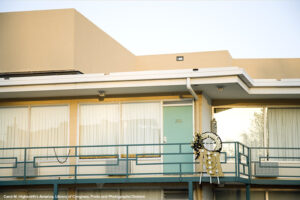
“Let Us In”
The House Intelligence Committee has officially begun its impeachment inquiry against Trump. The first stage of the investigation is to interview witnesses and gather testimony. This step is done behind closed doors and only by Committee leaders, to keep witnesses from working together to collaborate on their testimony.
But last week, about two dozen House Republicans intentionally entered the secure interview area, claiming that all Republican lawmakers should have access to the interview testimony (even though Intelligence Committee rules forbid it). The Republicans chanted “Let us in!” They also brought their cell phones with them, which is against security policy, and even ordered pizza for lunch after being told to leave. This disrupted the day’s proceedings and delayed the testimony of Laura Cooper (the Deputy Assistant Secretary of Defense for Russia, Ukraine, and Eurasia) for about five hours, until the GOP lawmakers finally left the secured area later that afternoon. Ironically, many of them are leaders of committees that also head up the impeachment inquiry. As such, they would have been allowed in the interview room without having to storm it.
House Intelligence Committee leaders say that there will be public hearings in the future so that all Americans will be able to hear the testimony.
Dig Deeper The secure facility where the interviews take place is called an SCIF. Use Internet resources to discover what SCIF stands for, and to learn more about these special facilities. Write a short paragraph about what you find.
Assigned Seats at . . . Lunch?
You’ve probably experienced some version of this terrible feeling in the past: You walk into the lunchroom and can’t find a place to sit, or any friends to sit with. Or maybe your lunchroom has certain tables where different cliques like to congregate? All of this can be very stressful for students and lead to social divisions, loneliness and isolation, and even bullying.
Some schools have decided to combat this problem by assigning seats at lunchtime. At one K-12 private school in Wisconsin, students are assigned to round tables that seat eight people. The tables are a mix of grade levels, and each one also has a staff member whose job it is to keep the conversation going. The tables rotate regularly, giving students a chance to interact with many of their peers from different grades or backgrounds. Other schools have tried similar approaches.
Supporters say that assigning seats at lunch cuts back on bullying and reduces stress among students: no one ever has to eat alone or rush through the lunch line to get a spot at a table. Teachers say it also reduces lunch room chaos. And while it would be impossible to eliminate cliques entirely, assigned lunch seats may be one simple way to help break down destructive social barriers and create a more positive experience for students overall.
What Do You Think? You come to school tomorrow and learn that your school as decided to start assigning seats at lunch. What’s your reaction? Why?
The Potomac’s Shipwreck Graveyard
Can you guess where the largest collection of shipwrecks in the world is? It’s not off of some exotic coast or deep at the bottom of the ocean. It’s in the Potomac River, about 30 miles south of Washington, D.C. Mallows Bay, as the area is called, houses about two hundred World War I-era shipwrecks.
So how did they wind up there? In 1917, President Woodrow Wilson ordered that the U.S. build an emergency fleet of a thousand wooden ships in just eighteen months, to replace the Allied ships being rapidly sunk by the Germans in the Atlantic. American companies (189 of them in 26 states) raced to build the ships as quickly as possible. In fact, on July 4, 1918, 95 ships were launched in just one day. But four months later, the war ended, and the U.S. government was suddenly stuck with a fleet of 296 essentially useless wooden steamships. A handful were sold to other countries and a few more domestically, all for very little money. The remaining two hundred were bought by a group of lawyers from California and taken to Alexandria, Virginia, where they were scavenged for any valuable parts. The leftover wooden hulls were tied together, pushed into the Potomac, and sunk.
Over the years, people salvaged what they could from the wreckage. Today, the bottom 10-20 percent of the hulls remain. The area is now a national marine sanctuary, and many of the hulls have become wildlife habitats. They also draw tourist dollars from people wanting to kayak and explore the wrecks: a piece of history still visible above the waterline at low tide.
Dig Deeper How many Allied ships were sunk by German submarines during World War I? Use Internet resources to help you determine your answer.
The Thirty-Year Protest (and Counting)
You’ve likely seen it before in your history textbooks: the iconic 1968 photograph of Dr. Martin Luther King, Jr., standing on the balcony of the Lorraine Motel in Memphis, Tennessee, immediately before his assassination. You can still visit the spot today; it has been preserved as part of the National Civil Rights Museum, where the façade of the motel remains, banked by two vintage 1960s-era cars and a wreath of flowers in the location where King was killed.

But one woman has made fighting this place her life’s work. Jacqueline Smith has been protesting in the same spot across the street from the Lorraine Motel for thirty years. In 1988, Smith was homeless and living in the motel, when she was evicted to make way for the new National Civil Rights Museum being built. The museum, which opened in 1991, cost $8.8 million in initial construction. Today, the cost of a ticket is $17 per person. Smith’s argument is that this doesn’t represent Dr. King’s values or mission and that he would have wanted instead to have allocated those funds to help the poor, homeless, and disadvantaged. She also believes that the museum and the preservation of the motel glorify Dr. King’s death rather than celebrate his life and many contributions. She would prefer that it would be torn down, and to show this, she sits every day with her back to it.
In the 28 years that the museum has been open, many national and world leaders have visited the museum and the iconic site. Former President Jimmy Carter, however, refused to enter the museum. Instead, he posed for photos with Smith. Today, she continues to sit in silent protest, flanked by her signs, and eager to share her story with anyone (world leader or otherwise) who approaches her for more information.
